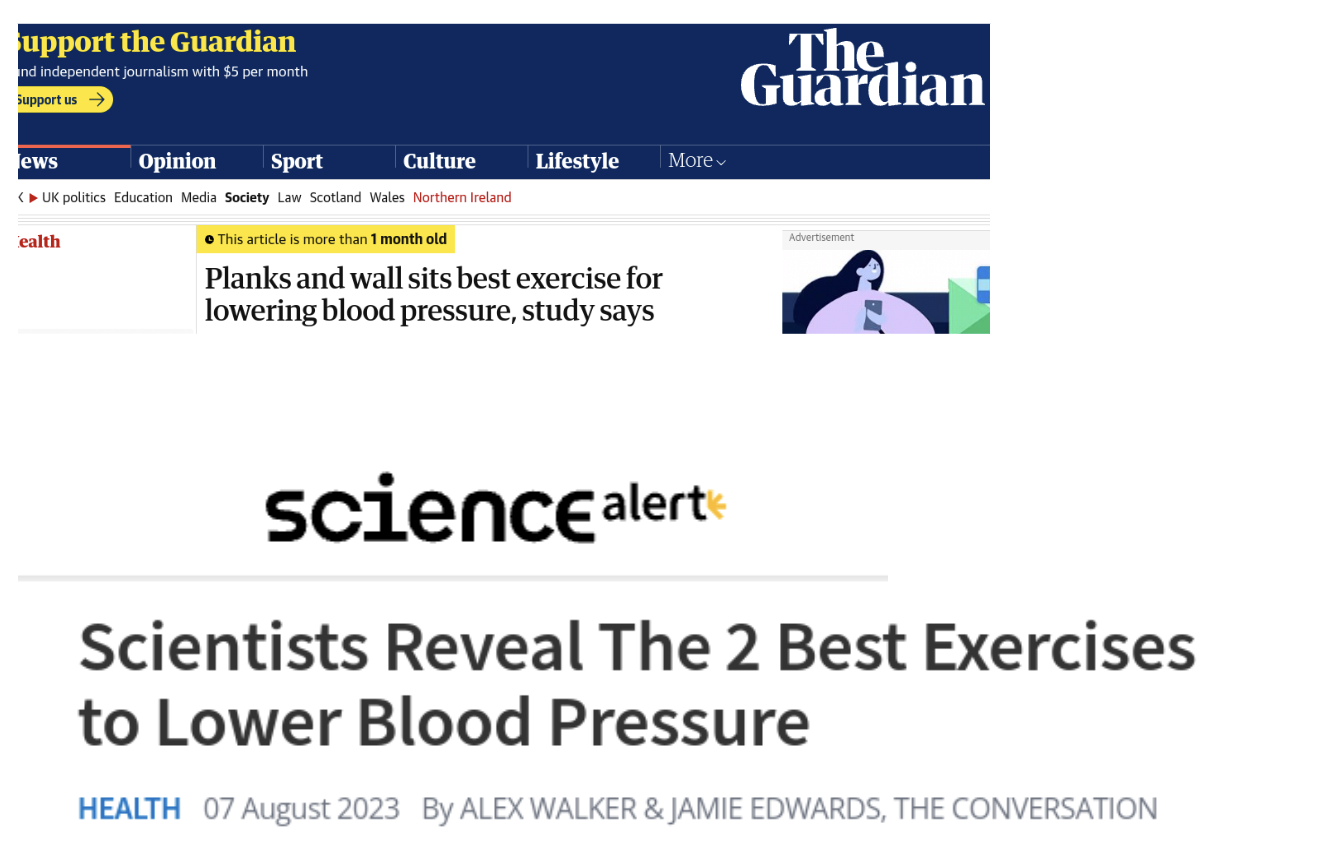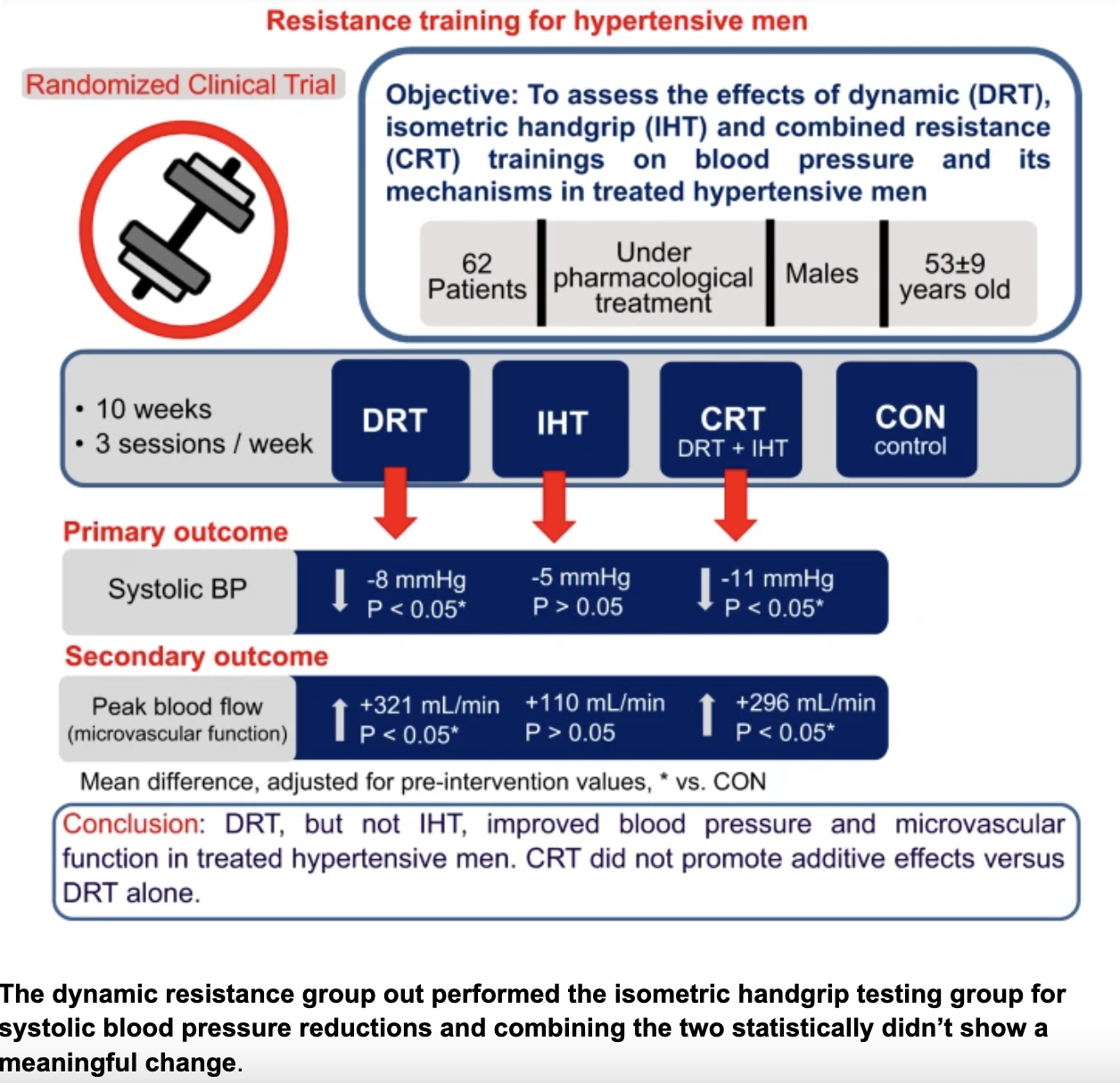Planks and wall squats for lowering blood pressure?

Extra! Extra! Read all about it!
Breaking news: Planks and wall squats lower blood pressure.
It’s a great headline, right? Everyone knows managing blood pressure over the long haul is an important component of your health. And the headline gives you a specific, recognizable and accessible solution. It’s a winning formula for click bait for a health conscious reader.
So it’s no wonder that this recent BJSM meta analysis got picked up by 181 news outlets. These authors must have been tickled to get such unprecedented attention from an academic paper.
These were some of the actual headlines:



That last one really makes you feel like you need to pay attention doesn’t it?! Like a project that has been under wraps for decades that is finally ready to be shared with the world!
These headlines are persuasive, meant to do what headline’s are supposed to do, entice you to read the article (or at least click into the article).
And not surprisingly after this barrage of stories headlining planks and wall squats for your blood pressure, patients started asking us about it…some even started doing planks or wall squats for the first time.
This got our attention, more than the initial study itself.
So do you really need to be doing isometric exercises, such as planks and wall squats, to manage your blood pressure?
In short, the answer is no. But the better answer may in fact be maybe (or for the lawyers out there, ‘it depends’).
What are isometric exercises?
Isometric exercises involve sustained contractions against an immovable load or resistance with no change or minimal change in the length of the involved muscle group. Generally this is thought of as muscular effort, without movement occurring. Think of pushing against a wall, or holding your body still in a challenging yoga posture fighting gravity or holding your dog’s leash while they are pulling toward that pesky squirrel! It takes muscular effort to create or resist those forces.
The theory is that isometric resistance causes some constriction of local blood vessels and upon releasing the contraction returning blood flow causes a rebound enlargement (dilation) of the blood vessel. It is thought that progressive exposure to this type of training can improve the blood vessel’s response to surges of pressure and blood flow and may even increase the blood vessel’s diameter.
And yes other forms of muscle contractions (isometric and concentric) also affect blood flow. However, it is possible the duration of the contraction differentiates it in some way from the typically shorter duration blood flow restriction that might occur with a concentric (shortening) or eccentric (lengthening) movement/exercise.
Isometric exercise and blood pressure
First off the original research on isometric exercise and its effect on blood pressure has primarily focused on grip resistance and wall squats.
While a plank is a good example of a common isometric exercise. Journalist’s got a little creative adding them into this story as they weren’t actually studied in this research. Minor editorial detail I guess.
This recent network meta-analysis combined the existing exercise trials and found that isometric exercise training on average reduced systolic blood pressure by 8.24 mm HG and diastolic blood pressure 4 mm Hg. Reductions in aerobic exercise training, high intensity interval training, dynamic resistance training and combined training showed reductions in the range of 4-6 mm Hg for systolic and 2.5-3 mm Hg for diastolic.
The result sounds convincingly in favour of isometric exercises over other forms of exercise if blood pressure is your primary goal. However, the biggest limitation to this conclusion is in the methodology of the analysis itself. These trials did not directly test against one another. The existing data is all from trials that test one form of exercise against a control group.
The authors then combined the results from different studies which have varying conditions, including (but not limited to) study timeline, population being studied (for example age and how hypertensive were these groups to start with??) and how the exercise prescription was executed. From a research design perspective there is a lot of heterogeneity (or study variability) here. Heterogeneity is not good for lumping data together. This is a known limitation from network meta-analsyses in general.
Lets use a hockey example. Lets say you have some data from some games from 3 teams who have all played against the Leafs. On average the nasty Bruins win by 4 goals a game, the always tough Lightning win by 2 goals a game and the rebuilding Habs win by 2 goals a game. It’s tempting from this data to say the Bruins are the best team. But wouldn’t the better data to answer who is the best team be from a head to head evaluation? How do the Bruins do directly against the Lightning or the Habs. The analogy might not be perfect, but evaluation of superiority by proxy is not ideal.
When asking a scientific question, and coming to specific conclusions on what form of treatment is best we prefer trials directly comparing treatment groups against each other and a control group.
A recent study published in Nature in February 2023 did just that when it comes to isometrics vs dynamic resistance training for blood pressure. They have summarized their study in the following image.

This recent study in Nature cast’s doubt on the conclusion that isometric exercises work better than resistance training for blood pressure reduction.
The astute observer of the above trial might say hey a reduction of 11mm HG is better than 8mm Hg. And I would agree. Although not statistically significant, there may be some clinical significance that needs to be further tested.
And I want to be clear. Isometric exercises, including graded hand grip exercises and wall squats work for reducing blood pressure. And the safety profile for sedentary individuals or elderly individuals getting started on an exercise program may be preferable to a dynamic resistance exercise program.
In particular hand grip isometric exercises have been shown to be safe, effective and relatively easily accessible which is important for program delivery in some populations.
I can see some community based programs succeeding here by helping seniors or poorly mobile populations get started and show some cardiovascular results. So there may be a time and a place for isometric exercises to help manage blood pressure.
Your exercise time is precious
The current recommended protocols for isometric handgrip training or wall squats for lowering blood pressure is 4 sets of 2 minute holds. With 2 minute breaks built in that amounts to 14 minutes of work per session. (As a side note: the intensity for these isometric protocols is 30% of your maximum for hand grip resistance and a rate of perceived exertion of 4 out of 10 for wall squat).
Your exercise time is likely limited, therefore, how you spend that time is important. Isometric exercises have some value (especially in rehabilitation!), but you’ll be missing out on all sorts of movement variety and joint loading exposure if you focus too much time on this form of exercise.
For the average adult fitness enthusiast who may be struggling to get two resistance training sessions per week (CSEP guidelines ), are these results significant enough that a good chunk of your workout should be dedicated to isometric exercises? I don’t think so.
So, sorry to ruin the plank or wall squat for optimal blood pressure party. They are great exercises in specific situations…but I’m not convinced a healthy adult not struggling with blood pressure concerns needs to bother.
If subsequent trials continue to show a significant additive effect, like the recent Nature trial, I could be convinced in some specific cases of hypertension (high blood pressure) that adding some low intensity isometric exercise as accessory exercise to a comprehensive training plan could be worth a try.
The biggest factor in how effective any exercise plan will be is consistency. A mediocre plan that gets done often is much better than the perfect plan that hardly ever gets done. So choose forms of exercise you enjoy. Pick several different forms of exercise for movement variety and physiological challenge. And engage in these often.
Chances are if you do this consistently for many years, you won’t find yourself reaching for results in clickbait headlines like the ones highlighted in this article!
